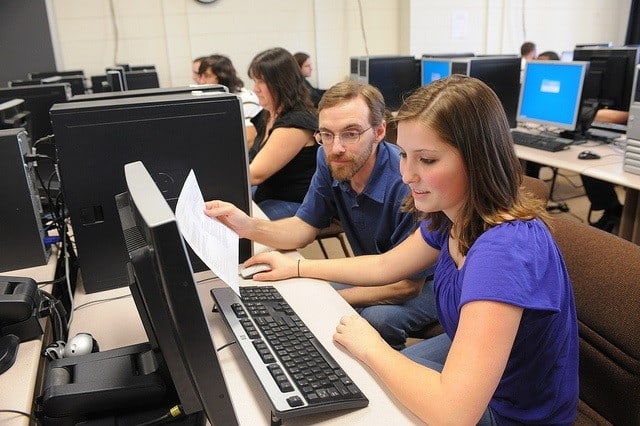Technological advancements have seeped into every corner of society, with education being no exception. For years, the practice of learning via computers and the internet has been mostly linked to higher education. However, K-12 education has become a bigger and bigger part of the virtual learning world. According to Connections Academy, more than 2.7 million K-12 students took part in blended or online learning programs in 2014. It has become clear that educators across the country are trying to integrate virtual learning into their world.
What Is Virtual Learning?
Virtual learning, often called eLearning or digital learning, is defined by the Mackinac Center for Public Policy as using “computer software, the internet or both to deliver instruction to students.” The methodology and deployment of virtual learning can vary depending on the teacher and the school. There are now entire K-12 schools dedicated solely to virtual learning, with teachers instructing through a virtual classroom environment. In fact, 315,000 students are enrolled in full-time online public schools, Connections Academy estimates. And most school districts (75 percent) are supplementing their daily lessons with some sort of virtual learning instruction.
Impact of Virtual Learning on K-12
There are several ways that virtual learning is affecting K-12 classrooms. These effects are making learning more accessible to students in new ways, but they can be challenging for teachers who must adapt to new methods. Here are a few examples.
BLENDED LEARNING
When a course is mixed between in-person instruction and virtual learning, it is called blended learning. One major benefit of technology is it allows for teachers to set up instruction that doesn’t require being physically present. If students have a lesson to complete in a virtual learning format, the teacher does not necessarily have to lead the class. It could be led by the software program, or it could be self-guided. This helps students in a blended learning program participate at a pace that works best for them and gives teachers much more flexibility.
IMPROVED MONITORING
A massive benefit of implementing virtual learning practices is the increased ability to monitor student progress. Software is widely available that makes it easier than ever for teachers to follow where students are no matter what. These programs even allow teachers to share grades and evaluations quickly with parents. This can keep everyone on the same page of how a student is doing in a course. These monitoring programs are easy to use and offer instant access from anywhere.
USE OF MOBILE DEVICES IN THE CLASSROOM
Most students of a certain age already have smartphones, and for years, they were seen as contraband in the classroom. More and more teachers are turning these powerful devices into a delivery mechanism for learning. They can use mobile devices to get real-time feedback from students, ask quick questions or allow for problem solving. Schools are also implementing tablets into the classroom in a similar fashion, allowing for a multifaceted learning experience.
SOCIAL NETWORKING FOR LEARNING
Just like mobile devices, educators are integrating educationally appropriate social networking sites in their classroom instruction. They are realizing that these sites are perfect for virtual learning, allowing students to collaborate easily outside the classroom. For those with privacy concerns, there are several social networks specifically set up for education and designed to keep kids safe.
ELECTRONIC AND INTERACTIVE TEXTBOOKS
When it comes to textbooks, virtual learning offers the promise of far more interactive content. The electronic format offers more powerful textbooks that offer videos, audio clips and other interactive activities to supplement a lesson. Interactive textbooks also allow for note taking and highlighting right in the document. This advancement allows students to have greater interaction with what they are learning.
ADAPTIVE LEARNING
Perhaps the biggest strength of virtual learning is how easily it can be adapted to meet the needs of each student. Many virtual learning environments can identify and react to places where students need increased support or where they are performing beyond expectations. Adaptive learning allows educators to easily pinpoint the needs of students and work more diligently to help them, without slowing down the entire class. This personalized form of learning can be highly effective and is still evolving.

Differences in Teaching Online
For some educators who haven’t ventured far into virtual learning, the idea may be daunting. It’s important for teachers to understand that they can prepare for the unique challenges of virtual learning.
DEVELOPING NEW AND ENGAGING LESSON PLANS
Virtual learning offers educators immense potential in the interactivity department. A good lesson plan in this format involves significant opportunities for engagement. Teachers should leverage the use of software and platforms that encourage engagement. Whether they include interactive textbooks, social networking or other interactive activities, teachers must offer supplemental instruction that takes full advantage of technology.
DEVELOPING DIGITAL ASSESSMENTS
Technological tools can be of unique help for assessing and measuring student progress. Digital assessments must be designed differently than traditional paper tests, and they can include audio or visual cues. Teachers can also use real-time assessment tools during a lesson to ensure that instruction is working.
UNDERSTANDING DIVERSITY IN THE CLASSROOM
One powerful feature of virtual learning is its ability to unite diverse classrooms more easily. Students with physical or learning disabilities can participate in virtual learning lessons at a pace that works for them, without impacting the rest of the classroom. As an educator, it is important to understand the diversity of students in the class. Learn how technology can unite students, whether the class includes students with disabilities, those of different cultures or other differences.
Overview of K-12 Virtual Learning in Kentucky
Virtual learning is alive and well in the Bluegrass State, with several options available to teachers and students wanting to participate.
KENTUCKY DEPARTMENT OF EDUCATION POLICY
The state created guidelines for digital learning “designed as guidance for schools, districts, and digital providers when selecting or creating developmentally appropriate digital learning resources for instruction, as well as online and blended learning courses in Kentucky schools.” They include guiding principles and language about content, assessments and more.
KENTUCKY VIRTUAL CAMPUS
The biggest virtual learning initiative in the state, the Kentucky Virtual Campus, offers a full catalog of online courses for K-12 students. Most courses are for high school students, but there are other options for younger students. Course topics range from health education to the Holocaust. Provided by Kentucky Educational Television, Jefferson County Public Schools and the Barren Academy of Virtual and Expanded Learning, these courses are offered to students unable to attend school, those who are home-schooled and others.
Embracing K-12 Virtual Learning
While virtual learning is still changing in the context of K-12 classrooms, it’s imperative that today’s educators understand how to embrace the trend. At Campbellsville University, our online graduate education programs provide advanced instruction on modern education concepts including the role of technology. Take the next step in your education career by learning more about our fully online Master of Arts in Education degree programs.




